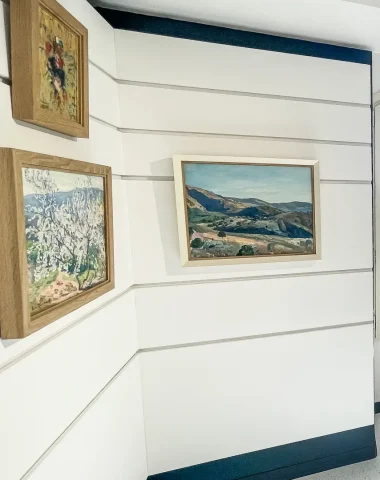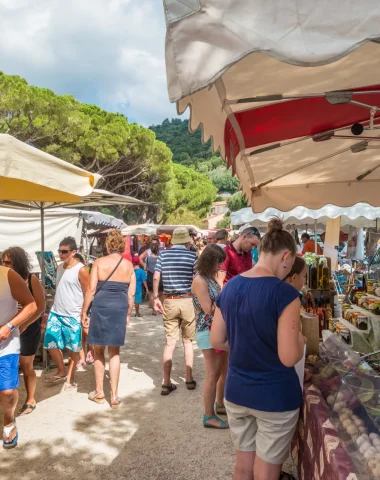Embark on a captivating journey along the Chemin des Sages, a project born from a visionary gathering of the Conseil des Sages, composed of wise individuals aged 60 and above, carefully chosen by local councilors for their wealth of experience. Inspired by the core principles of our Republican motto “Liberté, Égalité, Fraternité,” the council sought to breathe life into these ideals in the town of Bormes.
The Concept Takes Flight
A groundbreaking idea emerged during the council’s meeting—to adorn the town with phrases from renowned men and women, celebrated worldwide for their wisdom and humanism. The goal was to ignite the conscience of both passers-by and tourists, fostering a deeper connection with these universal values. To gain the support of the Mayor and the Council, the decision was made to integrate this pathway with the installation of historical plaques on the town’s iconic monuments. The members of the Conseil des Sages then meticulously designed the route through the medieval village and dedicated themselves to creating the perfect support, texts, images, and symbols for these plaques.

The butterfly, symbolizing joy, beauty, grace, and lightness of being, was chosen as the emblem of the project. Its transformative journey mirrors the essence of personal growth and rebirth. Just like the butterfly, we too experience different stages in life—a profound metamorphosis that allows us to release our past and embrace the beauty of who we’ve become. Symbolizing wisdom, the butterfly becomes a boundless source of inspiration. Beneath its delicate exterior lies an unwavering strength. Despite its ephemeral lifespan of a few days or weeks, the butterfly brings joy and exuberance through its graceful flight, fully savoring every moment that nature presents. Let us, like the butterfly, fearlessly embrace the experiences life offers us, both good and bad, knowing that they are fleeting. After all, our past experiences provide the best preparation for the future, allowing us to tread life’s paths with serenity.
The biography of Voltaire
Voltaire, a luminary of the Enlightenment, was a man of many facets – philosopher, freedom fighter, worldly poet, embattled writer, exile, courtier, "seigneur," and "patriarch" in his later years.
Born in Paris on November 21, 1694, he departed from this world on May 30, 1778. His remains found a final resting place in the Pantheon in a solemn ceremony in 1791. At the tender age of 7, he lost his mother, and his father, a notary, sought to raise him well.

From the age of 17, Voltaire harbored ambitions to become a man of letters. Educated by the Jesuits at the Collège Louis-le-Grand, he later pursued studies at the Faculty of Law in Paris. However, his fervent spirit led him to embrace libertinism and bel esprit, engaging in libertine circles and literary salons from 1715 onwards. His satirical writings landed him in the Bastille, where he penned Œdipe during his imprisonment.
Throughout his life, Voltaire’s adventures took him across Europe, embroiling him in court intrigues while continuing to contribute to the theatrical world. However, his writings against the Regent led to exile and imprisonment yet again. As a philosopher, Voltaire upheld the existence of God but criticized revealed religions, emphasizing the significance of morality. He detested fanaticism, championed democracy for small states, and refuted Rousseau’s belief in the innate goodness of man.
His literary accomplishments spanned a vast range, encompassing plays, philosophical tales, and historical and polemical texts. Notably, his Lettres philosophiques (1734) and Dictionnaire philosophique (1764) showcased his brilliance. Voltaire’s quest for tolerance was evident in his treatise on the subject.Bestowed the title of historiographer to the king in 1745, Voltaire remained deeply invested in storytelling, evidenced by works like Zadig. In his old age, he became the revered “Lord” and “patriarch” of Ferney. Yet, he returned to Paris, where he passed away in glory. As one of the key figures of the Enlightenment, Voltaire’s life was marked by unwavering dedication to the pursuit of freedom. His tireless efforts yielded an extensive and diverse body of work, revitalizing the historical genre and elevating fairy tales to new heights of literary excellence.
The museum and its past lives
Standing proudly as one of the city’s oldest residences, this historic building was constructed in the mid-17th century on Rue des Fours, the first street located outside the protective castle ramparts. The street underwent name changes, evolving from Grande Rue to Rue Carnot in 1894, in honor of the president bearing the same name.
Over the years, the building served a myriad of purposes. It once housed a small school for boys, functioning as a municipal school from 1660. Additionally, it was a place where schoolmistresses imparted Christian virtues to young girls in another part of the village. As a true community hub, it witnessed council meetings, elections, and lively debates. At times, it even acted as a prison and court for minor cases. However, in 1788, the growing number of pupils and the dilapidated state of the building prompted the commune to consider constructing a new town hall-school.

Enter 1892, and the vision for the new town hall and school materialized on Place Saint-François, separating the court and prison from the educational institution. The old building was nearly demolished, but a fortunate turn of events led to its rescue. In 1934, a Parisian antique dealer named Lucien Metzger acquired part of the building and, along with his wife, set about restoring and expanding it. Linking the two buildings and adding a second floor, they created a grand living room and meticulously restored the ceilings.
Fast forward to 1978, and the commune made a pivotal decision to purchase the building. A transformative process ensued, leading to its rebirth as the Musée Charles Cazin. Through extensive renovations and refurbishments, the building opened its doors to the public, becoming a venue for exhibitions and diverse cultural activities. Restoration efforts continued in 1982, culminating in the refurbishment of the façade in 1983.
A testament to resilience, this historic building has endured the test of time, playing an integral role in the rich history and cultural heritage of Bormes les Mimosas. From a municipal school to a treasured museum, it stands as a cherished symbol of the town’s past and future.

To experience the full splendor of the Chemin des Sages and delve deeper into the fascinating stories that unfold along this path, we invite you to explore the Baludik app.
Scan the QR code and embark on an interactive journey filled with games, surprises, and a deeper connection to the rich heritage of Bormes.














